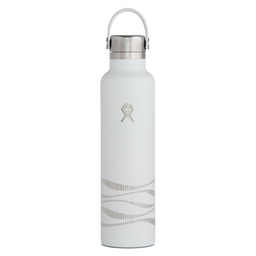In the contemporary landscape of consumer culture, the evolution of water bottles from mere vessels for hydration to coveted lifestyle accessories warrants critical examination. The phenomenon reflects a broader trend wherein mundane objects are elevated to symbols of status and self-expression. S’well bottles, characterized by their sleek design, pattern variety, and eco-friendly materials, exemplify this transformation. With a premium price point, they appeal to a demographic that prioritizes both fashion and sustainability.
Similarly, Hydro Flask has cultivated a reputation for durability and versatility, leveraging advanced insulation technology to maintain beverage temperatures for extended periods. In 2019, these bottles became closely associated with the cultural phenomenon of “VSCO girls.” Originating from the VSCO photo-editing app, VSCO girls embody a laid-back, environmentally conscious aesthetic, often seen sporting oversized t-shirts and carrying reusable water bottles. Hydro Flask’s commitment to sustainability made it a favored accessory among VSCO girls, with its brightly colored bottles becoming emblematic of the trend. This association underscored the influence of social media on shaping consumer behavior and highlighted the commercialization of subcultures by brands.
On the other hand, Owala bottles, boasting innovative features such as the FreeSip® spout and Easy-Carry LoopTM, target consumers seeking convenience without compromising performance. Meanwhile, Stanley Cups have transitioned from utilitarian outdoor gear to fashionable accessories, embodying a rugged charm favored by mainstream influencers
What distinguishes this trend is the emergence of a vibrant culture surrounding water bottles. From social media influencers to do-it-yourself enthusiasts, individuals are imbuing these everyday objects with personal flair, evident in the viral “get ready with me” videos featuring accessorized Stanley Cups. This phenomenon underscores the intersection of consumerism and self-expression in the digital age.
However, amidst the allure of trendy water bottles lies a sobering reality: the transient nature of consumer trends. The meteoric rise and subsequent decline of brands like Hydro Flask serve as poignant reminders of the ephemeral nature of popularity. As the zeitgeist shifts, so too do consumer preferences, leaving once-coveted products relegated to discount store shelves.
Ultimately, the water bottle trend offers insights into the complex dynamics of contemporary consumer culture. It prompts reflection on the role of branding, sustainability, and individual expression in shaping purchasing decisions. While water bottles may serve as outward manifestations of personal style and values, their significance pales in comparison to broader societal issues. As consumers, it behooves us to approach trends with discernment, recognizing that true value lies beyond the surface allure of fashionable accessories.
In the vast landscape of internet trends, even the humble tumbler has had its moment in the spotlight. But sometimes a cup is just a cup in the right place at the right time. This statement captures the essence of how fleeting these trends can be. We enthusiastically embrace them, only to discard them when the next big thing comes along, perpetuating a cycle of manic consumption.
But what may seem like a natural evolution of taste and preference is often meticulously orchestrated by corporate strategists. Behind the scenes, companies invest significant resources in engineering these moments of ubiquity. They study market trends, analyze consumer behavior, and fine-tune their marketing campaigns to ensure maximum exposure.
Just like influencers curate their online personas to attract followers, brands leverage our attention to convert online viewers into loyal customers. The goal is to create a buzz that transcends the digital realm and infiltrates popular culture. It’s a delicate dance between supply and demand, with companies vying for a coveted spot in the collective consciousness.
However, the ephemeral nature of internet fame means that success is far from guaranteed. Take, for example, the rise and fall of Hydro Flask. Once the darling of the water bottle world, its popularity has waned, as evidenced by discounted stacks gathering dust on store shelves. What was once a must-have accessory is now relegated to bargain bins at HomeGoods.
Enter Owala, the latest contender in the tumbler arena. With endorsements from informed friends and fervent converts, it’s poised to become the next big thing. But in a market driven by fleeting trends and fickle consumer preferences, the road to success is fraught with uncertainty.
The transient nature of trendy tumblers serves as a microcosm of broader consumer culture. We chase after the latest fads, seeking validation and belonging in the products we buy and the brands we endorse. Yet, in our relentless pursuit of novelty, we often overlook the inherent value of timeless classics.
So the next time you find yourself caught up in the whirlwind of internet hype, take a moment to pause and reflect. Ask yourself: is this tumbler truly worth the hype, or is it just another shiny object destined to fade into obscurity? Only time will tell.


